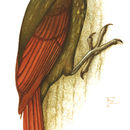en
names in breadcrumbs


The spotted woodcreeper (Xiphorhynchus erythropygius) is a species of bird in the Dendrocolaptinae subfamily. It is found in Belize, Colombia, Costa Rica, Ecuador, El Salvador, Guatemala, Honduras, Mexico, Nicaragua, and Panama.
Measuring 22 cm (8.7 in) long, the spotted woodcreeper has an olive-brown head, back and breast. The head is spotted, turning into short streaks on the back. The breast is also spotted with oblong buffy spots. This species also has a distinct buffy eyering.[2]
Its natural habitats are subtropical or tropical moist lowland forests and subtropical or tropical moist montane forests. It is found at all levels of the canopy, and is often part of mixed-species foraging flocks.[2]
It is not considered a threatened species by the IUCN.
The spotted woodcreeper (Xiphorhynchus erythropygius) is a species of bird in the Dendrocolaptinae subfamily. It is found in Belize, Colombia, Costa Rica, Ecuador, El Salvador, Guatemala, Honduras, Mexico, Nicaragua, and Panama.
Measuring 22 cm (8.7 in) long, the spotted woodcreeper has an olive-brown head, back and breast. The head is spotted, turning into short streaks on the back. The breast is also spotted with oblong buffy spots. This species also has a distinct buffy eyering.
Its natural habitats are subtropical or tropical moist lowland forests and subtropical or tropical moist montane forests. It is found at all levels of the canopy, and is often part of mixed-species foraging flocks.
It is not considered a threatened species by the IUCN.
 Tandayapa Valley, NW Ecuador
Tandayapa Valley, NW Ecuador